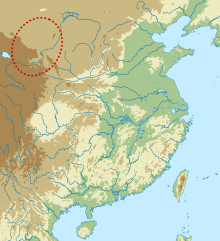
Back Cultura de Qijia Catalan Qijia-Kultur German Cultura Qijia Spanish Culture de Qijia French Cultura di Qijia Italian 斉家文化 Japanese 치자 문화 Korean Qijiacultuur Dutch Qijiakulturen NB Цицзя Russian
 | |||||||
| Geographical range | upper Yellow River | ||||||
|---|---|---|---|---|---|---|---|
| Period | early Bronze Age | ||||||
| Dates | c. 2200 – c. 1600 BC | ||||||
| Preceded by | Majiayao culture | ||||||
| Followed by | Siwa culture Siba culture Xindian culture Shanma culture | ||||||
| Chinese name | |||||||
| Traditional Chinese | 齊家文化 | ||||||
| Simplified Chinese | 齐家文化 | ||||||
| |||||||
The Qijia culture (2200 BC – 1600 BC) was an early Bronze Age culture distributed around the upper Yellow River region of Gansu (centered in Lanzhou) and eastern Qinghai, China. It is regarded as one of the earliest bronze cultures in China.
The Qijia Culture is named after the Qijiaping Site (齐家坪) in Gansu Province.
Prior to Qijia culture, in the same area there existed Majiayao culture that was also familiar with metalwork. At the end of the third millennium B.C., Qijia culture succeeded Majiayao culture at sites in three main geographic zones: Eastern Gansu, Middle Gansu, and Western Gansu/Eastern Qinghai.[1]
The Qijia culture benefited from the warm and humid climatic conditions from the Late Glacial to the Middle Holocene, which led to flourishing agricultural production and rapid population growth. These conditions changed with the aridification of the Late Holocene, provoking material and cultural decline.[2]
- ^ Neolithic period Archived 2013-08-17 at the Wayback Machine – Princeton University Art Museum
- ^ Li, Yu; Zhang, Zhansen; Zhou, Xueru; Gao, Mingjun; Li, Haiye; Xue, Yaxin; Duan, Junjie (1 May 2023). "Paleo-environmental changes and human activities in Shiyang River Basin since the Late Glacial". Chinese Science Bulletin: 3884. doi:10.1360/TB-2022-0965. S2CID 257736583.
The long period of warm and humid climatic conditions from the Late Glacial to the Middle Holocene favoured the development and expansion of the Majiayao and Qijia cultures. This stable and agriculturally suitable climate was conducive to increased food production, which contributed to rapid population growth. However, the continuous aridification that began in the Late Holocene led to a decline in agricultural production and insufficient food and water supply, which hampered population growth and cultural development.